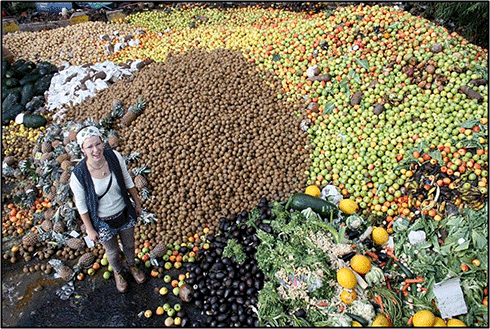
|
Published: 9 September 2013
Our materials footprint may be smaller, but still oversize
For some time Australians have been considered among the biggest consumers of natural resources in the world. According to previous studies, we each get through 70 tonnes of materials every year. This is way higher than other developed nations. But could something be influencing these figures?

|
|
While the picture for Australia’s consumption now looks a little less bloated, we still consume more resources per person than most other nations on earth – largely thanks to our significant amounts of food waste, large houses with poor energy efficiency, large travel distances, and a diet heavy in meat and dairy products. Credit: Oxfam Australia/ 3things.org.au under CC BY-NC 3.0 AU licence
|
Traditional analysis of international consumption of natural resources suggests countries such as Japan and the United Kingdom are consuming less as their economies grow, suggesting growth and resource use can be decoupled. Unfortunately, a closer look shows some countries are simply off-shoring the resource consumption they use to feed their growth.
Our new study shows something is missing from traditional analysis: the upstream natural resource requirements of imports and exports. With these included, the picture of national resource consumption changes dramatically.
Fossil fuels, minerals, ores, timber and food are critical to the global economy. The methods used so far to quantify natural resource-use measure the flow of materials, energy, waste and emissions within a nation or region. This delivers an estimate for domestic material consumption: the amount of material and energy flow per person for that nation or region.
By this measure, Australia is one of the largest users of natural resources in the world. Japan has a domestic material consumption of around 10 tonnes per person, and the United Kingdom is even lower, at around 8 tonnes per person.
Measured this way, it seems reasonable to claim nations such as Japan and the UK are finally managing to decouple economic growth from resource consumption – something of a holy grail achievement as we face a resource-restricted future.
But the claim is based on misleading data. The domestic material consumption approach is flawed because it fails to account for two very important factors: the resource requirements of imports and exports.
This difference between consumption-based and territorial accounting is well known for greenhouse gas emissions. We know that you can count a country’s emissions either by looking at emissions generated in the country, or emissions generated in creating things that the country consumes. In our new paper published in PNAS, we now replicate this method for total use of primary resources.
This is known as the ‘material footprint’ approach. Material footprint measures the total amount of primary resources required to service consumption in a country, whether those resources are found within the borders of that country or are imported from elsewhere.
Calculating the material footprint is more complex than calculating domestic material consumption because it requires the additional inputs of global material flows. We used global and national data on primary resource extraction, and a multi-regional global input-output table showing the material flow relationships around the world.
From that, we were able to attribute resource flows, wherever they originated from, to the point of final consumption. We calculated the result for the past two decades.
When viewed through the material footprint lens, the global picture of resource consumption looks very different.
What we see now is that Australia’s material footprint is actually around 35 tonnes of material per person – a vast improvement on 70 tonnes per person. The reason for this is that a significant proportion of the natural resources that are extracted and harvested within our boundaries are exported overseas for consumption elsewhere.
In contrast, the material footprint of the United Kingdom is around 24 tonnes per person and Japan’s material footprint is around 28 tonnes per person. A significant proportion of goods and resources consumed in those countries are imported.
As a result, we can no longer say that the UK and Japan are making headway towards decoupling consumption from economic growth. In fact, their growing economies are still demanding greater and greater amounts of natural resources, and our data suggest that with every 10 per cent increase in GDP the average national material footprint increases by 6 per cent.
According to the material footprint measure, most OECD nations fit somewhere between the 25–35 tonnes per person mark. This gives us a much clearer forecast of how global resource consumption might change in the future, as the standard of living in developing nations approaches that currently enjoyed by those of us living in the industrialised world.
By 2050, a global population of 9 billion people would require an estimated 270 billion tonnes of natural resources to fuel the level of consumption we are used to in OECD countries. This is dramatic increase from 70 billion tonnes consumed in 2010. Global consumption of primary resources would be four times as large compared to today, leading to much larger environmental impacts as well.
While the picture for Australia’s consumption now looks a little less bloated, we still consume more resources per person than most other nations on earth. For example, and emerging nation like India would consume about 5 tonnes per person, while the US and Japan would consume about 28 tonnes. Australia is still probably one of the highest consumers.
This is largely thanks to our resource-intensive lifestyle of large houses with poor energy efficiency, large travel distances, significant amounts of food waste, and a diet heavy in meat and dairy products. These factors alone account for much of the difference in consumption between Australia and Japan.
So while the material footprint story reveals that the Australian economy is not nearly as resource-hungry as we have been led to believe previously, it does show that we have significant room for improvement in order to achieve a low-carbon, resource efficient economy.
Dr Heinz Schandl leads CSIRO's research group for Social Systems, Institutions and Governance in the Social and Economic Sciences Program. This group of sociologists, anthropologists and human geographers study the complex interactions of social, economic and political processes with the environment at multiple levels, for example, the sustainable use of natural resources. Dr Thomas (Tommy) Weidmann is an Associate Professor and leader of the Sustainability Assessment Program in the School of Civil and Environmental Engineering at the University of NSW. This article was originally published at The Conversation.



